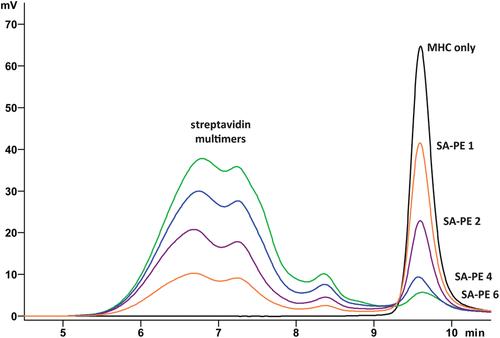Jolien J. Luimstra, Kees L. M. C. Franken, Malgorzata A. Garstka, Jan W. Drijfhout, Jacques Neefjes, Huib Ovaa
{"title":"Production and Thermal Exchange of Conditional Peptide-MHC I Multimers","authors":"Jolien J. Luimstra, Kees L. M. C. Franken, Malgorzata A. Garstka, Jan W. Drijfhout, Jacques Neefjes, Huib Ovaa","doi":"10.1002/cpim.85","DOIUrl":null,"url":null,"abstract":"<p>Cytotoxic CD8<sup>+</sup> T cells mediate cellular immunity through recognition of specific antigens presented by MHC class I on all nucleated cells. Studying T cell interactions and responses provides invaluable information on infection, autoimmunity and cancer. Fluorescently labeled multimers of MHC I can be used to quantify, characterize, and isolate specific CD8<sup>+</sup> T cells by flow cytometry. Here we describe the production and use of conditional MHC I multimers that can be loaded with peptides of choice by incubating them at a defined temperature. Multimers are folded with a template peptide that forms a stable complex at low temperature, but dissociates at a defined elevated temperature. Using this technology multiple MHC I multimers can be generated in parallel, to allow staining and isolation of large sets of antigen-specific CD8<sup>+</sup> T cells, especially when combined with barcoding technologies. © 2019 The Authors.</p>","PeriodicalId":10733,"journal":{"name":"Current Protocols in Immunology","volume":"126 1","pages":""},"PeriodicalIF":0.0000,"publicationDate":"2019-07-26","publicationTypes":"Journal Article","fieldsOfStudy":null,"isOpenAccess":false,"openAccessPdf":"https://sci-hub-pdf.com/10.1002/cpim.85","citationCount":"9","resultStr":null,"platform":"Semanticscholar","paperid":null,"PeriodicalName":"Current Protocols in Immunology","FirstCategoryId":"1085","ListUrlMain":"https://onlinelibrary.wiley.com/doi/10.1002/cpim.85","RegionNum":0,"RegionCategory":null,"ArticlePicture":[],"TitleCN":null,"AbstractTextCN":null,"PMCID":null,"EPubDate":"","PubModel":"","JCR":"Q2","JCRName":"Immunology and Microbiology","Score":null,"Total":0}
引用次数: 9
Abstract
Cytotoxic CD8+ T cells mediate cellular immunity through recognition of specific antigens presented by MHC class I on all nucleated cells. Studying T cell interactions and responses provides invaluable information on infection, autoimmunity and cancer. Fluorescently labeled multimers of MHC I can be used to quantify, characterize, and isolate specific CD8+ T cells by flow cytometry. Here we describe the production and use of conditional MHC I multimers that can be loaded with peptides of choice by incubating them at a defined temperature. Multimers are folded with a template peptide that forms a stable complex at low temperature, but dissociates at a defined elevated temperature. Using this technology multiple MHC I multimers can be generated in parallel, to allow staining and isolation of large sets of antigen-specific CD8+ T cells, especially when combined with barcoding technologies. © 2019 The Authors.

条件多肽- mhc I多聚体的制备和热交换
细胞毒性CD8+ T细胞通过识别MHC I类在所有有核细胞上呈递的特异性抗原介导细胞免疫。研究T细胞的相互作用和反应为感染、自身免疫和癌症提供了宝贵的信息。荧光标记的MHC I多聚体可用于定量,表征,并通过流式细胞术分离特异性CD8+ T细胞。在这里,我们描述了条件MHC I多聚体的生产和使用,这些多聚体可以通过在规定的温度下孵育而装载选择的肽。多聚体与模板肽折叠,模板肽在低温下形成稳定的复合物,但在特定的高温下解离。使用该技术,可以并行生成多个MHC I多聚体,以便对大量抗原特异性CD8+ T细胞进行染色和分离,特别是与条形码技术结合使用时。©2019作者。
本文章由计算机程序翻译,如有差异,请以英文原文为准。


 求助内容:
求助内容: 应助结果提醒方式:
应助结果提醒方式:


